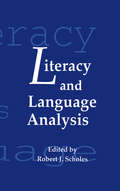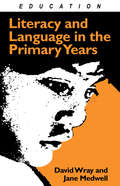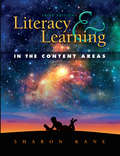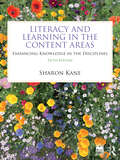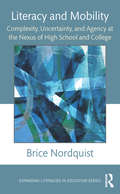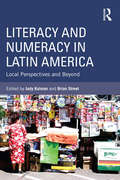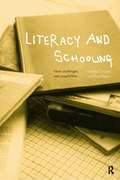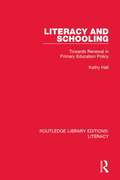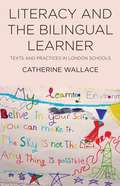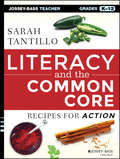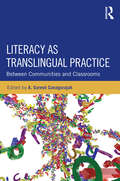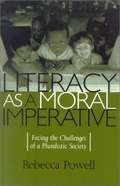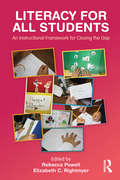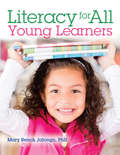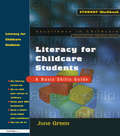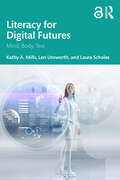- Table View
- List View
Literacy and ICT in the Primary School: A Creative Approach to English
by Andrew RuddBy clearly outlining how ICT can enhance and improve children’s learning, this book unlocks the full potential of ICT within the classroom. Stimulating, useful and free of jargon, the book provides many practical examples to show teachers where, when and how ICT can be used effectively within literacy teaching. It provides advice on: teaching creatively using ICT in the Foundation Stage making the most of your resources planning and assessment. Rooted in the practical realities of the classroom, this book will support both trainee and qualified teachers in providing rich and creative literacy experiences through the use of technology.
Literacy and Identity Through Streaming Media: Kids, Teens, and Representation on Netflix (Expanding Literacies in Education)
by Damiana Gibbons PylesIn this book, Damiana Gibbons Pyles guides readers through the fast-changing landscape of digital streaming services such as Netflix and explores their impact on children’s and teens’ identities. Children interact with streaming media in novel, hidden, and unforeseen ways that shape their digital, material, affective, and embodied worlds. By analyzing how Netflix represents gender, race, and ethnicities, Gibbons Pyles explores how this new media phenomenon portrays and influences young people’s development and sense of self, and how streaming media pushes children and teens to particular ways of being in its interfaces, algorithms, and content. Drawing primarily on Bakhtinian, feminist, and female Black scholarship, her incisive analysis reveals how the new media streaming phenomenon molds children’s understandings of their ways of being in the world. Ideal for scholars and graduate students in literacy education, media studies, and communication, the text is an illuminating view into the hidden role of streaming services as an essential, complex component of literacy scholarship.
Literacy and Language Analysis
by Robert J. ScholesThis volume investigates the interconnections between language and literacy in terms of the structures of language as well as the linguistic contexts of literacy. The work for this book was generated in order to focus on studies of the acquisition and impact of literacy on traditional assertions of linguistic analysts. The contributors show that claims regarding descriptions of the linguistic competence of native speakers contain phonemic, morphemic, and sentential constructs applicable only to literate language users. They also suggest that syntactic formalities -- elements lacking extensional reference -- are unlikely in the absence of literacy, and that the notions of "sentencehood" and syntactic well-formedness are functions of literacy. Finally, the book reviews the basic notions of literary relativity and the role of literacy in communication and civilization.
Literacy and Language in East Asia: Shifting Meanings, Values and Approaches
by Peter Kell Marilyn KellThis book critically explores why some Asian nations are on top of the world in students' achievement tests in reading and literacy, yet governments and industry in these nations are anxious about a crisis in education. Why are governments anxious about the capabilities and skills of school and university graduates in a global economy when there is a Asian economic boom? The authors explore questions about how the Asian countries value test-based examination curriculum and its influence on the practices of teaching learning and the lives of young people in Asia. The authors describe the challenge of change for East Asian nations to develop more relevant approaches to literacy and language and more inclusive societies focussed on the needs of young people and not exam results.
Literacy and Language in the Primary Years
by Jane Medwell David WrayLinking the development of reading, writing, speaking and listening, this book offers a distinctive holistic approach to literacy and language acquisition. It emphasizes the value of active, collaborative learning, and includes sections on literacy accross the primary curriculum, new technology and assessment. Each chapter is linked to a component of the National Curriculum Programme and contains points of interest, sources of further information and suggestions for follow-up actvities in the classroom.
Literacy and Learning in the Content Areas
by Sharon KaneThe 3rd Edition of Literacy & Learning in the Content Areas helps readers build the knowledge, motivation, tools, and confidence they need as they integrate literacy into their middle and high school content area classrooms. Its unique approach to teaching content area literacy actively engages preservice and practicing teachers in reading and writing and the very activities that they will use to teach literacy to their own studentsin middle and high school classrooms . Rather than passively learning about strategies for incorporating content area literacy activities, readers get hands-on experience in such techniques as mapping/webbing, anticipation guides, booktalks, class websites, and journal writing and reflection. Readers also learn how to integrate children's and young adult literature, primary sources, biographies, essays, poetry, and online content, communities, and websites into their classrooms. Each chapter offers concrete teaching examples and practical suggestions to help make literacy relevant to students' content area learning. Author Sharon Kane demonstrates how relevant reading, writing, speaking, listening, and visual learning activities can improve learning in content area subjects and at the same time help readers meet national content knowledge standards and benchmarks.
Literacy and Learning in the Content Areas: Enhancing Knowledge in the Disciplines
by Sharon KaneThe fifth edition of Literacy and Learning in the Content Areas: Enhancing Knowledge in the Disciplines provides readers with the knowledge, motivation, tools, and confidence for integrating literacy in their disciplinary classrooms. Offering a literature-based approach to teaching disciplinary literacy, the new edition shares important ways in which teachers of courses in the disciplines can enhance student learning of subject matter and skills while also fostering their growth in the many facets of literacy. Throughout each chapter, Kane provides engaging and creative strategies and activities to make literacy come alive in discipline-specific courses and to encourage students to explore and learn in the classroom. Embedded in each chapter are examples, resources, and strategies to help readers actively engage with and implement literacy practices. These features include Teaching in Action examples by subject area; Activating Prior Knowledge activities to stimulate critical thinking to prepare readers to learn complex theoretical and conceptual material about teaching, learning, and literacy; and end-of-chapter Application Activities to apply field experiences to classroom use.New to the Fifth Edition Every chapter of this new edition is updated to reflect the current approaches, standards, and benchmarks for discipline-specific literacy A new introduction with reading activities for professors to exemplify a common reading experience with their students, supported by online reading materials New book talks to highlight books that show disciplinary thinking in action, including literature related to art, physical education, economics, computer science, engineering, food science, music, robotics, environmental science, family and consumer science, and technology Expanded practical instructional strategies, with new examples focused on STEAM (science, technology, engineering, art, math) fields and topics relating to diversity and language, ESL/ENL, and modern language learning Updated examples and activities to emphasize students’ active involvement in their own learning
Literacy and Learning in the Content Areas: Enhancing Knowledge in the Disciplines (Fourth Edition)
by Sharon Kane<p>The Fourth Edition of Literacy and Learning in the Content Areas: Enhancing Knowledge in the Disciplines provides readers with the knowledge, motivation, tools, and confidence for integrating literacy in their disciplinary classrooms. Offering an original, literature-based approach to teaching disciplinary literacy, the new edition shares important ways in which teachers of courses in the disciplines can enhance student learning of subject matter and skills while also fostering their growth in the many facets of literacy. Throughout each chapter, Kane provides engaging and creative strategies and activities to make literacy come alive in discipline-specific courses and to encourage students to explore and learn in the classroom. <p>Embedded in each chapter are examples, resources, and strategies to help readers actively engage with and implement literacy practices. These features include Teaching in Action examples by subject area; Activating Prior Knowledge activities to stimulate critical thinking to prepare readers to learn complex theoretical and conceptual material about teaching, learning, and literacy; and end-of-chapter Application Activities to apply field experiences to classroom use. <p>New to the Fourth Edition: <p> <li>Every chapter of this new edition is updated to reflect the current approaches, standards, and benchmarks for discipline-specific literacy. <li>Enhanced Companion Website with BookTalks to introduce relevant books in many genres and subjects, encouraging readers to explore the books for themselves and providing a model for BookTalks in their own classrooms. <li>Expanded practical instructional strategies for teaching literacy in math, science, and social studies. <li>Updated to include newly published titles in children’s literature, young adult literature, and nonfiction.</li> </p>
Literacy and Mobility: Complexity, Uncertainty, and Agency at the Nexus of High School and College
by Brice NordquistPushing forward research on emerging literacies and theoretical orientations, this book follows students from different tracks of high school English in a "failing" U.S. public school through their first two years in universities, colleges, and jobs. Analytical and methodological tools from new literacy and mobility studies are employed to investigate relations among patterns of movement and literacy practices across educational institutions, neighborhoods, cultures, and national borders. By following research participants’ trajectories in and across scenes of literacy in school, college, home, online, in transit, and elsewhere, the work illustrates how students help constitute and connect one scene of literacy with others in their daily lives; how their mobile literacies produce, maintain, and disrupt social relations and identities with respect to race, gender, class, language, and nationality; and how they draw upon multiple literacies and linguistic resources to accommodate, resist, and transform dominant discourses.
Literacy and Motivation: Reading Engagement in individuals and Groups
by Catherine E. Snow Ludo VerhoevenThe central question in this volume is how to create a society of "engaged readers" in today's world, where reading is increasingly overruled by other media, such as television and personal computers. Engaged readers, as the term is used in this book, means readers who are socially interactive, strategic, and motivated. This state-of-the-art review contains research on integrating cognitive, social, and motivational aspects of reading and reading instruction, the chapter authors argue that coming to grips with the notion of engagement in literacy requires redefining literacy itself to acknowledge the degree to which it is not only a cognitive accomplishment, but a social activity and an affective commitment as well. Promoting literacy acquisition thus requires interventions that address attitudes and beliefs as much as those that assure cognitive changes in learners. Equally important, the authors posit that literacy engagement involves the integration of cognitive strategies and motivational goals during literate activities. This necessary link between literacy and motivation is addressed from a variety of perspectives. Acknowledging the value of cross-national and cross-cultural comparisons, the book features chapters on the promotion of literacy in different regions around the world.
Literacy and Multimodality Across Global Sites (Routledge Research in Literacy #9)
by Maureen KendrickOver the past three decades, our conceptualizations of literacy and what it means to be literate have expanded to include recognition that there is a qualitative difference in how we communicate through modalities such as the visual, audio, spatial, and linguistic and that different modes are combined in complex ways to make meaning. The field of multimodality is concerned with how human beings use different modes of communication to represent or make meaning in the world. Despite the rapid growth of international research in this area, accounts of a broader range of global sites, particularly economically under-resourced and culturally diverse contexts such as Sub-Saharan Africa, remain under-researched and under-represented in the literature. This book contextualizes a range of literacies including health literacies, community literacies, family literacies, and multilingual literacies within broader modes of communication, most specifically play and the visual. The claim is that powerful pedagogies, methodologies and theories can be constructed by taking a more detailed look at multimodal meaning-making in diverse contexts. By describing and analyzing multimodal practices and texts across a diverse range of contexts, the book highlights different constructs, issues and emerging questions dealing with the study of literacies and multimodality.
Literacy and Numeracy in Latin America: Local Perspectives and Beyond
by Brian Street Judy KalmanLatin American Literacy and Numeracy Studies (LALNS) are fairly unknown in other parts of the world. This book charts new directions in LALNS and explores the relationship between these studies and international perspectives. Calling upon social practice approaches, New Literacy Studies, sociolinguistics, discourse analysis and other paradigms, the contributors identify both convergent and divergent literacy and numeracy issues within the region as well as beyond the Latin American context. Literacy and Numeracy in Latin America moves the field forward by bringing LALNS into wider focus and helping readers to understand the synergy with work from other perspectives and from other parts of the world and the implications for theory and practice. A lack of translated work until now between Latin America and, in particular, the UK, US, and Europe, has meant that such important overlaps between areas of study have gone unappreciated. In this way this volume is the first of its kind, a significant and original contribution to the field.
Literacy and Power (Language, Culture, and Teaching Series)
by Hilary JanksHilary Janks addresses key questions about literacy and power in this landmark text that is both engaging and accessible. Her central argument is that competing orientations to critical literacy education ? domination (power), access, diversity, design ? foreground one over the other, but are crucially interdependent and need to work together to create possibilities for redesign and social action that serve a social justice agenda. She examines the theory underpinning each orientation, and develops new theory in the argument for interdependence and integration. Sitting at the interface between theory and practice, constantly moving from one to the other, the text is rich with examples of how to use these orientations in real teaching contexts, and how to use them to counterbalance one another. In the groundbreaking final chapter Janks considers how the rationalist underpinning of critical literacy tends to exclude the non-rational shows ways of working ‘beyond reason’ ? pleasure and play, desire and the unconscious ? and makes the case that these need to be taken seriously given their power to cut across the work of critical literacy educators working from any orientation.
Literacy and Schooling
by Frances Christie and Ray MissonThis book is intended to offer an introduction to some major themes in literacy education. Literacy has become an important issue both in the UK and internationally, and this book aims to inform discussions while assisting teachers to reflect on their work as literacy teachers. Literacy is important from the earliest years through all the years of formal education, and so this book covers work with students in the full range of schooling, and in a number of different subject areas. Topics covered include: *the nature and use of texts *the reading positions that are constructed in texts and their ideological implications *the ways in which written texts change as students grow older *moving from the early years through to secondary education *the implications of Information Technology for literacy teaching Frances Christie is Foundation Professor of Language and Literacy Education at the University of Melbourne. Ray Misson is Senior Lecturer in Language and Literacy Education at the University of Melbourne.
Literacy and Schooling: Towards Renewal in Primary Education Policy (Routledge Library Editions: Literacy #8)
by Kathy HallOriginally published in 2004. In this book Kathy Hall analyses recent educational reform in England relating to primary education and literacy. By taking account of themes such as globalisation, teacher education, children's learning and especially literacy, she develops a critique of government reactions and explores alternative responses to the crucial issues of our time. The book concludes with policy recommendations based on evidence drawn from a range of perspectives. Inviting the reader to consider what is happening in primary education generally, and in literacy more specifically, the book will prove both thought– and action– provoking.
Literacy and the Bilingual Learner: Texts and Practices in London Schools
by Catherine WallaceLiteracy and the Bilingual Learner explores the literacy development of bilingual learners in London (UK) schools and colleges through a series of vignettes and case studies of learners and their educational experiences.
Literacy and the Common Core: Recipes for Action
by Sarah TantilloTools and Insights for Meeting and Exceeding the Common Core Standards Literacy and the Common Core offers K-12 teachers clear guidance on how to design units, lessons, and objectives to meet the Common Core State Standards in English Language Arts; it's filled with practical strategies that teachers can use immediately to target key standards; and it describes how to analyze the standards to support instructional planning and curriculum development.This book aims to make life a little easier for everyone--teachers, school leaders, parents, and students--as we all strive to prepare students for college and the careers they most desire. The book includes practical tools,templates, and rubrics ready to be downloaded and customized to meet your needs. Additional resources may be found on the companionsite, www.literacycookbook.com. Here are just a few of the essential topics addressed: Which standards to start with and how to tackle them. How to bridge the gap when students are not on grade level. How to engage and support parents. How to teach students to write effectively. How to translate the standards for actual use. Take the recipes in this book, make them your own, and enjoyyour new "Common Core Master Chef" status!
Literacy as Translingual Practice: Between Communities and Classrooms
by A. Suresh CanagarajahThe term translingual highlights the reality that people always shuttle across languages, communicate in hybrid languages and, thus, enjoy multilingual competence. In the context of migration, transnational economic and cultural relations, digital communication, and globalism, increasing contact is taking place between languages and communities. In these contact zones new genres of writing and new textual conventions are emerging that go beyond traditional dichotomies that treat languages as separated from each other, and texts and writers as determined by one language or the other. Pushing forward a translingual orientation to writing—one that is in tune with the new literacies and communicative practices flowing into writing classrooms and demanding new pedagogies and policies— this volume is structured around five concerns: refining the theoretical premises, learning from community practices, debating the role of code meshed products, identifying new research directions, and developing sound pedagogical applications. These themes are explored by leading scholars from L1 and L2 composition, rhetoric and applied linguistics, education theory and classroom practice, and diverse ethnic rhetorics. Timely and much needed, Literacy as Translingual Practice is essential reading for students, researchers, and practitioners across these fields.
Literacy as a Moral Imperative: Facing the Challenges of a Pluralistic Society
by Rebecca PowellPowell argues that literacy instruction should encourage social responsibility and civic action and should nurture a culture of compassion and care.
Literacy for All Students: An Instructional Framework for Closing the Gap
by Rebecca Powell Elizabeth RightmyerThe Culturally Responsive Instruction Observation Protocol (CRIOP) is a framework for implementing culturally relevant literacy instruction and classroom observation. Drawing on research and theory reflecting a range of perspectives multicultural instruction, literacy theory, equity pedagogy, language and discourse models, sheltered instruction, critical pedagogy it provides a means for assessing the many variables of classroom literacy instruction and for guiding practitioners in their development as multicultural educators. Literacy for All Students Discusses issues in multicultural literacy instruction within the context of various essential instructional components (such as assessment, curriculum, parent collaboration) Provides a protocol for observing features of literacy instruction for culturally and linguistically diverse students Presents vignettes from real classrooms, written by elementary and middle school teachers, showing their victories and struggles as they attempt to implement a pedagogy that is culturally responsive within a climate of high stakes testing A highly effective instrument for assessing culturally responsive literacy instruction in schools, the CRIOP serves as a model for realizing a literacy that is both relevant and transformative.
Literacy for All Young Learners
by Mary JalongoEarly childhood classrooms are becoming more and more diverse. Dual languages and a wide range of reading abilities require that teachers have the resources to reach all learners in their classrooms. In Literacy for All Young Learners, Mary Jalongo, PhD, offers 65 strategies to support literacy learning with children from preschool through the third grade. With specific suggestions for ELL students, Jalongo includes recommendations for hundreds of great children's books, websites, and apps to make teaching easier. Each strategy is designed to be simple to use with all of the children in your classroom--from the not-yet-readers to the fluent readers--and each strategy is tied to the Common Core State Standards for kindergarten through third grade. Downloadable digital content includes sample parent letters in English and Spanish, extra book-based activities, and technology supports.
Literacy for All: A Framework for Anti-Oppressive Teaching (Equity and Social Justice in Education Series #0)
by Shawna CoppolaAn equity-conscious, culturally sustaining approach to literacy education. Every student comes to the classroom with unique funds of knowledge in addition to unique needs. How can teachers celebrate and draw upon the valuable literacies each child already possesses to engage them more effectively in school literacy practices? In Literacy for All, Shawna Coppola shows how a literacy pedagogy founded on anti-oppressive principles can transform the experiences of teachers and students alike. Using her framework, which highlights the social and cultural aspects of literacy, teachers can help students participate in literacy experiences that illuminate their individual strengths. Coppola’s book, an ideal introduction for equity-conscious literacy educators, shows how to design instructional and assessment practices that reflect both the cognitive processes and the social practices inherent in learning to read and write.
Literacy for Childcare Students: A Basic Skills Guide
by June GreenThis pack offers the busy tutor all they need to teach their childcare students literacy. This pack offers the busy tutor all they need to teach their childcare students literacy. The book includes: * Pages of spelling quizzes * Pages for building their bank of familiar words * Extension activities which build on what they've learned in lessons The students will be able to chart their own progress as they work through the levels.
Literacy for Digital Futures: Mind, Body, Text
by Kathy A. Mills Len Unsworth Laura ScholesThe unprecedented rate of global, technological, and societal change calls for a radical, new understanding of literacy. This book offers a nuanced framework for making sense of literacy by addressing knowledge as contextualised, embodied, multimodal, and digitally mediated. In today’s world of technological breakthroughs, social shifts, and rapid changes to the educational landscape, literacy can no longer be understood through established curriculum and static text structures. To prepare teachers, scholars, and researchers for the digital future, the book is organised around three themes – Mind and Materiality; Body and Senses; and Texts and Digital Semiotics – to shape readers’ understanding of literacy. Opening up new interdisciplinary themes, Mills, Unsworth, and Scholes confront emerging issues for next-generation digital literacy practices. The volume helps new and established researchers rethink dynamic changes in the materiality of texts and their implications for the mind and body, and features recommendations for educational and professional practice.
Literacy for QTLS: Achieving the Minimum Core
by Julia HickeyLiteracy for QTLS is written specifically with the needs of all those training to teach or currently working in the lifelong learning sector in mind. This highly practical and easy-to-use text will help you identify your areas of strength and weakness, develop your knowledge and skills in order to pass the national literacy test and adopt strategies that you can use to support the language and literacy skills of your own learners.Packed with test-your-knowledge questions, examples and recommendations for best practice, this book, closely linked to the QTLS standards, is essential reading for all those needing to ensure that their level of literacy and language is in line with the minimum core requirements.The text is accompanied by a Companion Website at www.pearsoned.co.uk/hickey, providing an electronic version of the self-audit sections, downloadable templates and additional resources.


